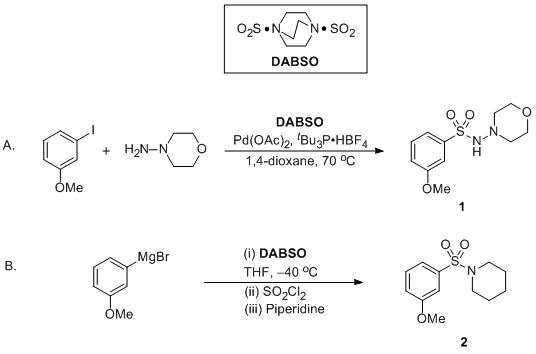31Phosphorus NMR
The 1D 31Phosphorus NMR experiment is much less sensitive than Proton (1H) but more sensitive than 13Carbon. 31Phosphorus is a medium sensitivity nucleus that yields sharp lines (fig. 1) and has a wide chemical shift range. It is usually acquired with 1Hdecoupling (fig. 2) means that spin-spin couplings are seldom observed. This greatly simplifies the spectrum and makes it less crowded. Where there are one-bond 31P-1H couplings present then the decoupling power needs to be at lest twice that needed for 13C because of the large coupling constant.
Fig. 1. Typical 31P-NMR spectrum of a mixture of organic phosphates
Integration is inaccurate (almost useless when there is one-bond coupling to 1H) in a regular decoupled 31P NMR spectrum because of uneven NOE enhancement of the signals by decoupling and long longitudinal relaxation times (T1's). Quantitative spectra may be obtained by inverse gated decoupling.
Gated decoupling may be used in order to observe proton couplings (fig. 4). If coupling constants are required then a phosphorus coupled proton spectrum (fig. 5) is much more sensitive than the phosphorus spectrum although the reduced chemical shift range may cause overlapping that make analysis more difficult. One-bond couplings are typically 600 to 700 Hz, two-bond 20 to 30 Hz, three-bond 5 to 10 Hz and four-bond <1 Hz. Couplings may be observed with other nuclei such as 19Fluorine.
Fig. 2. 31P-NMR spectrum of diethylphosphite with 1H decoupling
Fig. 3. Molecular structure of deithylphosphite
Fig. 4. spectrum of diethylphosphite showing one-bond and three-bond coupling to 1H
Fig. 5. 1H-NMR spectrum of diethyl phosphite showing coupling to 31P
A typical analysis of a 31P NMR spectrum consists of matching expected chemical shifts to the expected moieties. Each type of signal has a characteristic chemical shift range (fig. 6).
Fig. 6. Chemical shift ranges of phosphorus according to their chemical environment
Choose the structure that most closely represents the phosphorus in question. R = alkyl or H.
The heteronuclear coupling patterns between phosphorus and proton can be used to assign the proton spectrum (figs. 7, 8).
Fig. 7. 1H-NMR spectrum of sphingomyelin showing the effects of 31P coupling
Fig. 8. 31P-NMR spectrum of sphingomyelin showing the effects of 1H coupling
Properties of 31P
| Property | Value |
|---|---|
| Spin | ½ |
| Natural abundance | 100% |
| Chemical shift range | 430 ppm, from -180 to 250 |
| Frequency ratio (Ξ) | 40.480742% |
| Reference compound | 85% H3PO4 in H2O = 0 ppm |
| Linewidth of reference | 1 Hz |
| T1 of reference | 0.5 s |
| Receptivity rel. to 1H at natural abundance | 6.63 × 10-3 |
| Receptivity rel. to 1H when enriched | 6.63 × 10-3 |
| Receptivity rel. to 13C at natural abundance | 37.7 |
| Receptivity rel. to 13C when enriched | 37.7 |
xxxxxxxxxxxxxxxxxxxxxxxxxxxxxxxxxxxxxxxxxxxxxxxxxxxxxxxxxxxxxxxxxxxxxxxxxxxxxxx

PAGE CREATED BY DR ANTHONY MELVIN CRASTO M.SC, Ph.D (ORGANIC CHEMISTRY,24+ years experience in the field of research and development, currently with Glenmark-Generics Ltd, Navi Mumbai, India
Ентоні アンソニー Αντώνιος 安东尼 แอนโทนี Энтони אַנטאַני Антхони एंथनी 안토니 أنتوني
NAME: DR. ANTHONY MELVIN CRASTO.
Principal scientist, GLENMARK-GENERICS LTD
Navi mumbai, INDIA
Email amcrasto@gmail.com
MOBILE+91-9323115463
TWITTER- @amcrasto
web links
Anthony in different languages
安东尼 Энтони एंथनी 안토니 Anthony in different languages
アンソニー 安东尼 Энтони एंथनी 안토니 أنتوني
|
To take full advantage of Chemical Web content, it is essential
to use several Software:Winzip,Chemscape Chime, Shockwave,
Adobe Acrobat, Cosmo Player, Web Lab Viewer,
Paint Shop Pro, Rasmol, ChemOffice, Quick Time,etc.
to use several Software:Winzip,Chemscape Chime, Shockwave,
Adobe Acrobat, Cosmo Player, Web Lab Viewer,
Paint Shop Pro, Rasmol, ChemOffice, Quick Time,etc.
Suggested viewers and plug-ins for optimal viewing pleasure
Here is where you find the links to all of the plug-ins available on
Here is where you find the links to all of the plug-ins available on
TheFreeDictionary Google
?
Word / Article Starts with Ends with Text
|
click here for patents



